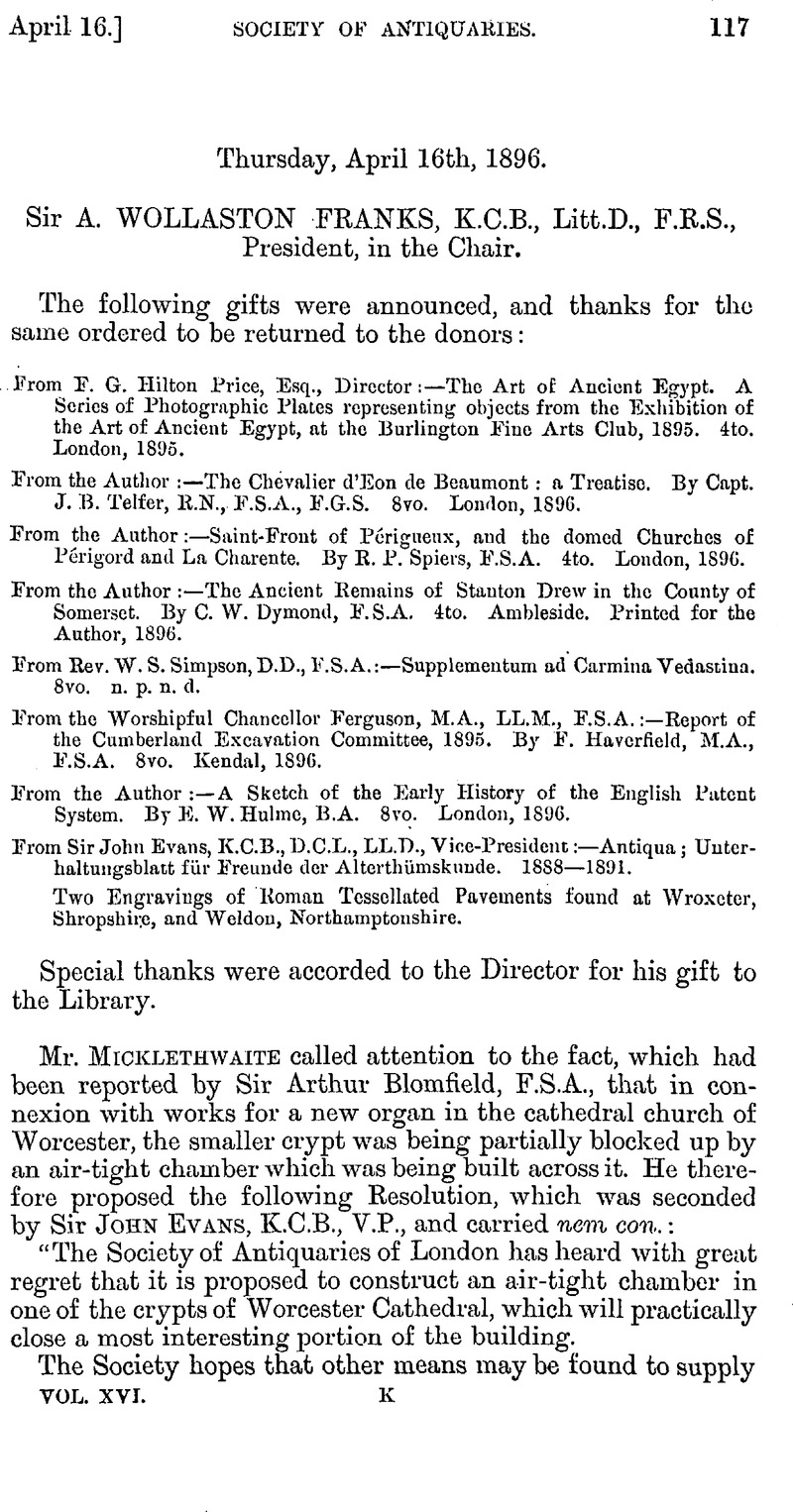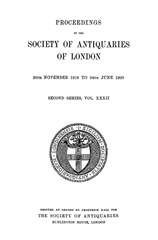No CrossRef data available.
Article contents
Thursday, April 16th, 1896
Published online by Cambridge University Press: 10 May 2010
Abstract

- Type
- Proceedings
- Information
- Copyright
- Copyright © The Society of Antiquaries of London 1897
References
page 122 note * A phonetic spelling is necessary here; few now would put the right pronunciation to the orthodox faughten.
page 124 note * Cennino Cennini, Trattato della pittura (Roma, 1821), cap. cxiii.
page 124 note † Cennino Cennini, Trattato, &c., cap. cxx.
page 124 note ‡ See Theophilus, De diversis artibus &c. Ed. Hendrie (London, 1847), lib. i. cap. xix. pp. 22, 23.
page 125 note * Cennini's provincial Italian is often obscure. Terra, “earth,” must really mean “clay,” as in terra-cotta. “Crea” I have assumed to be a misprint for “cera” wax, as more likely to be used for a mould than chalk, as translated by Mrs. Merrifield, for though “crèa” accented means “creta,” that word also means “clay,” and is used even by old Italian writers for other subsoil. “Ungi,” literally “oil,” I have translated “smear,” as it is the obvious meaning.
page 125 note † “Lavoro ancora sopra il gesso stemporato con la medesima colla fregi, e diademe di relievo ed altri ornamenti tondi.” Vasari, Vita de Margaritone.
page 126 note * See “Observations on a Painting of Fourteenth Century,” &c., p. 205, in Norwich Volume of the Archæological Institute.
page 126 note † See Guide de la Peinture. Manuscrit Byzantin traduit par le Dr. Paul Durand, p. 194.
page 126 note ‡ The fine illuminated page of the Litlington Missal, recently exhibited, does indeed show the same arrangement (as pointed out by Mr. Hope), except that the figure stands firmly, and it cannot be doubted that it had a similar origin.
page 127 note * This action occurs in a MS. at the Soane Museum (circa 1480), but then it is by one of the scourgers ; also in a picture at Bologna by Ludovico Carraci, though we do not place a painter of the seventeenth century in the Middle Ages.
page 128 note * Mr. Way considered this to be the origin of the torse in heraldry. It was doubtless derived from the turban of the East to protect the brows from the sun's heat.
page 130 note * “La centurion regards le Christ, il élève le main et benit Dien,” p. 195.
page 130 note † Essai sur les legendes picuses du moyen age, par Maury, L. F. Alfred, (Paris, 1843), 200Google Scholar.
page 130 note ‡ His words are, “e tutti dal mezo in dietro, o vero in giù, sono convertiti in aria.” It may be, however, that he dues not mean it to be an invention of Cavallini, though thus specially described.
page 132 note * Journal of the British Archæological Association, vii. pl. xxxix. The effigy is in Ashbourne church, Derbyshire, and is probably to the memory of Edmund Cockayn, circa 1402.
page 132 note † Norwich Volume, &c. p. 204.
page 132 note ‡ D'Agincourt, J. B. L. G. Seroux, Histoire de l'art par les Monumens (Paris, 1823)Google Scholar, and Brindley, W. and Weatherley, W. S., Ancient Sepulchral Monuments (London, 1887)Google Scholar, where all referred to are engraved.
page 134 note * “Dell 'Ascensione è ancora una tavola nel Carmine di Batista Naldini, disse il Michelozzo, di cui non è da passarsene con silentio. L'havervi fatto Santa Lena, e Santa Agnese, rispose il Vecchietto, che veunero al mondo tanto tempo dopo l'Ascensione del Signore, e la Vergine Maria giovanetta di diciotto anni o venti.”
“Ben è vero che nella tavola dello Spirito santo egli (Vasari) ha fatto la Reina de' Cieli una giovane dimostrante l'età di venti auni al piu, ed ella ne dovea havere intorno à cinquanta.” Il Riposo di Raffaello Borghini, &c. In Fiorenza, 1584. Appresso Giorgio Marescotti, pp. 111, 114.
page 135 note * Since writing the above, I have had the pleasure of a communication from the Rev. G. W. Minns, our Fellow, who visited St. Michael's-at-Plea in 1859), and made some rough pencil memoranda of the paintings then in the church, which he has kindly forwarded to me. He tells me in his letter that “a portion of the rood-screen was then in situ and formed part of a pew.” The subjects on this were a crucifixion, an archbishop, St. Erasmus and St. Margaret. The others were on loose panels, regarded as old boards, lying about in the vestry, (subjects as follow : The Resurrection, split in two pieces (now in same condition), the Annunciation, the Scourging, the Entombment, the Crucifixion, and Betrayal ; the last two being those I have described. But the Entombment and the Scourging have disappeared. The former was at the time split in two, and the latter was but a fragment. Yet this was of especial interest, as it must have been in some sort a replica of that on the retable. The figure of Christ showed the arms upraised bound above the head, which I have specially noted, and the position of Pilate is the same ; this however is all the sketch shows. The diapered ground is like that in the Betrayal, so I conclude from Mr. Minns' sketch.
The disappearance of these interesting fragments, which were extant twelve years after the visit of the Archæological Institute to Norwich, is one of those unhappy incidents to which we have too often to bear testimony. Nor can I consider the mode in which what now remain are huddled together to form a reredos desirable either as a matter of taste, or the way in which such valuable remains of the art of the Eastern Counties should be preserved, for it renders their study exceedingly difficult, and they no longer form that combination of subjects which was the principal of all medieval art. A museum is now the best place for their preservation.


